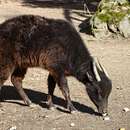Biology
provided by Arkive
The elusive mountain anoa appears to be a solitary animal, although suggestions that monogamous pairs remain together have been made, and there is evidence that females form herds when giving birth (5). Breeding is continuous throughout the year, with one calf born from each pregnancy lasting 275 to 315 days. Mothers will groom and protect their calves, but it is unknown how much involvement the male has with the rearing of the calf. Weaning has been assumed to take place at six to nine months, a similar length of time as for the lowland anoa. The mountain anoa is sexually mature at two years. It is not thought to be territorial, and is known to be most active in the morning and the late afternoon when they feed on vegetation and bathe in water and mud pools, spending the remaining time resting and ruminating (4) (5).
Conservation
provided by Arkive
Ongoing status surveys and genetic research are intended for use in clarifying the taxonomic ranking of mountain and lowland anoas, which is necessary before captive breeding of these species can take place. Whilst the mountain anoa has been protected in Indonesia since 1931, protected areas are poorly managed and enforcement is clearly an issue, even within the military (1) (4).
Description
provided by Arkive
This even-toed ungulate is actually a member of the wild cattle subfamily, but due to its small size, it more closely resembles a deer. Unlike the larger, short-haired lowland anoa, the mountain anoa has a longer, woolly coat which can be dark brown to black in colour. It moults every year between February and April, losing this woolly layer of fur to reveal light spots on the head, neck and limbs (5). The relatively small horns are evident in both males and females, and are conical and smooth (4). The mountain anoa is stocky, short-limbed and thick-necked (4).
Habitat
provided by Arkive
Very little is known about the habitat preferences of the mountain anoa, since it is a shy and little-studied animal. It is known to live at altitudes of between 500 and 2000 metres (1) (4), but reports differ on preferred habitats. Some say that the mountain anoa inhabits areas of dense forest that are vegetationally diverse, whereas other report that it likes areas of relatively open forest with a high density of understory plants in the vicinity of open areas and water sources. However, reports agree that mountain anoa cannot coexist with humans, which is unusual amongst the wild cattle of southeast Asia (1) (6).
Range
provided by Arkive
The mountain anoa is endemic to Indonesia, being present only in the province of Sulawesi and the nearby island of Buton (1) (5).
Status
provided by Arkive
The mountain anoa is classified as Endangered (EN C1 + 2a) on the IUCN Red List 2003 (1) and is listed on Appendix I of CITES (2). It is also listed as Endangered on the US Endangered Species Act (4) and is fully protected under Indonesian law (1).
Threats
provided by Arkive
This species is thought to have been in decline since 1900, and is known to have been declining since 1980. The major pressure on population numbers is habitat loss due to increasing agricultural land, forestry operations and deforestation for human settlement (1). Despite being protected under Indonesian law, mountain anoas are known to be shot by the military, possibly because they are thought to be aggressive when startled, and capable of harming humans. Hunting anoas for the meat, fur and horns still takes place even in protected sites such as nature reserves (1)

